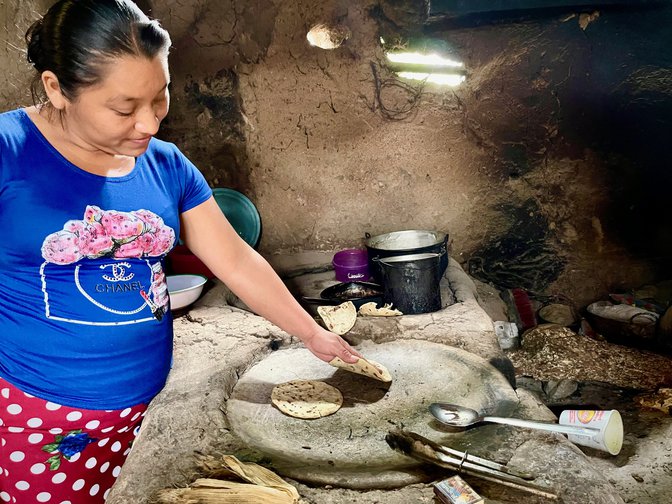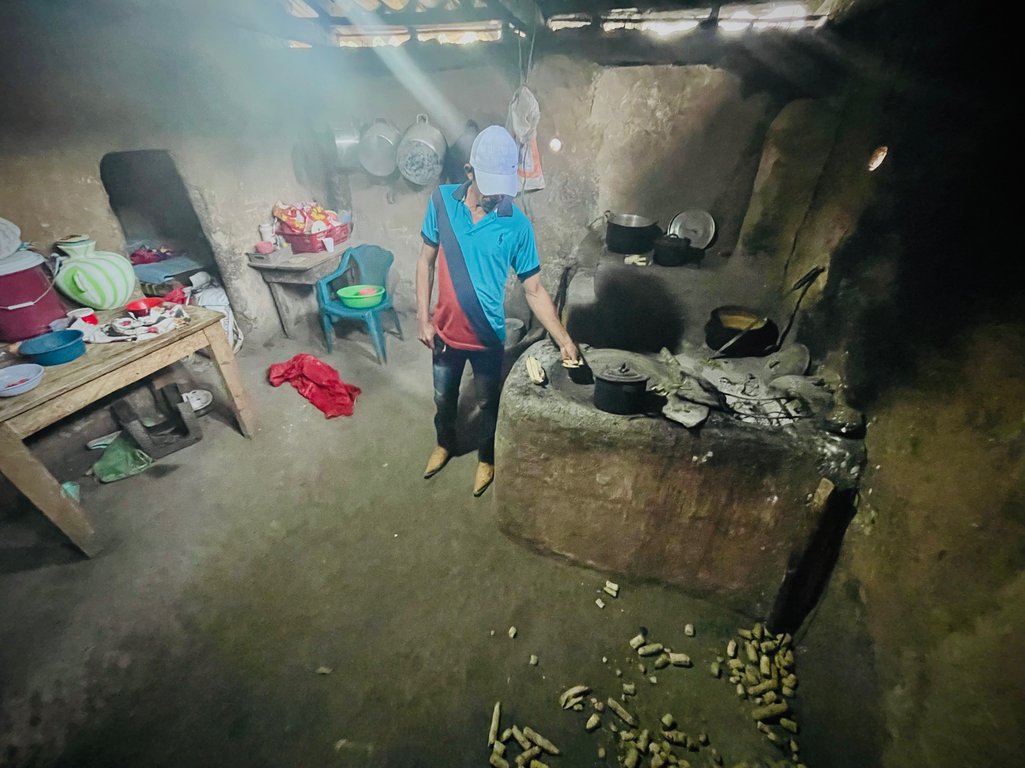
How a new seed gives Guatemalans a way out of hunger and bad health
Poor farmers in Guatemala eat little but maize. A first step out of malnutrition is a new seed bred to yield the vitamins and minerals they need

Steep slopes, sweltering weather, poverty and malnutrition: this is Camotán, a town in south-eastern Guatemala, home to the brothers Luis and Antonio Mejía. They have no monetary income: they live off the maize they harvest. Both are married fathers of young children and live in a small concrete and sheet-metal house, with no bathroom or electricity.
“My family and I eat around eight pounds of corn daily. Because I don’t have money, we usually eat tortillas without beans, about five or six per day, which will keep us full,” said Luis.
You can’t be healthy on that kind of diet. Ninety percent of Guatemalans living in extreme poverty eat the same food every day. They have very little opportunity to have a balanced diet rich in protein. And in Camotán, 41.1% of the population lives in extreme poverty, according to data from the Guatemalan Institute of Statistics.
Malnutrition is chronic among people like these. “In rural and low-income households, the diet is monotonous. They mostly consume maize and its derivatives, like tortillas,” said Mónica Mazariegos, a researcher at the Institute of Nutrition of Central America and Panama (INCAP). Guatemala has some of the highest risks of zinc and iron deficiency in Latin America.
We’ve got a newsletter for everyone
Whatever you’re interested in, there’s a free openDemocracy newsletter for you.
The Mejía brothers learned how to grow corn when they were little, Antonio, 40, recalled. “Our father taught us this type of activity as a form of survival when we were around eight years old,” he said.
They follow the same routine every day, waking up at 5am, walking for approximately 20 minutes to the field where they cultivate the corn, and coming back home around 6pm to eat tortillas.

Luís Mejía at home
Isabella Rolz. All rights reserved
While his wife and daughter stay at home throughout the day to prepare the tortillas and other corn-based food, Luis, 42, takes his ten-year-old son to the field to help him with the land work.
The work hasn’t changed, but now the family has better nutrition – thanks to a new kind of maize seed.
Semilla Nueva, a non-profit initiative operating in Guatemala since 2017, has given them a hybrid seed, bred by conventional selective breeding – not genetic modification – that has more essential nutrients than the maize the brothers grew before.
"Our solution improves the cheapest and most culturally significant food, which is corn," said Curt Bowen, co-founder and executive director of Semilla Nueva. "The F3 maize seed is bred to increase the crop's density of vitamins and minerals. Since it is consumed regularly by these farmers and families, this agronomic practice will make a huge impact on the population's nutritional status."
The process of making food more nutritious food like is called biofortification. “Biofortification focuses on adding specific micronutrients that are insufficient in the diets of low-resource populations of developing countries that rely heavily on a single staple food, such as maize,” said Jere Haas, a nutrition expert at Cornell University in Ithaca, New York.
By distributing biofortified seeds, he said, we can “correct the micronutrient deficiencies of iron, zinc, and vitamin A that contribute to a high burden of diseases and disabilities in these low-resource populations”.
Both Luis and Antonio Mejía describe the F3 seed as “softer and more abundant” than other corn seeds. They’ve also noticed that their families have become less ill in the last few years, and their children have more energy throughout the day.

The Mejía family children in the doorway of their home
Isabella Rolz. All rights reserved
Antonio’s wife, María Mejía, 30, who spends most of her day in the kitchen making the tortillas, said that with the F3, she notices “that the tortillas are getting bigger, more yellowish and are heavier”, which makes the family feel fuller.
The new seeds don’t solve all their problems, though. “Biofortification is an elegant tool to improve the human health of poor people [but] it is not perfect and needs to be combined with other methods as necessary,” said Stephan Haefele, an expert in sustainable soils and crops at Rothamsted Research, a non-profit research centre in the UK.
Even though the Mejía family seems healthier since they started farming the biofortified seed, it’s not easy to measure how much of the increased nutrient intake is really taken up in the body. For this reason, there’s a debate about how much biofortification helps to remedy the nutrient deficiency.
There can be trade-offs too. “In some cases, the biofortified crops yield slightly [lower volumes of produce] than the best normal varieties, in which case the dilemma is between feeding people enough calories or sufficient micronutrients,” said Haefele.
There is no reported risk in eating conventionally biofortified crops. Still, not everyone will accept them immediately. “A challenge can be due to possible alteration in the taste and look of edibles that need to be adopted by the population,” said Abdul Wakeel, an assistant professor at the University of Agriculture Faisalabad in Pakistan.
Farmers need more than just a one-off delivery of seeds, too. “It’s a continuous process to maintain and sustain the biofortified varieties, and simultaneously soils need to be fed with minerals, especially if they are deficient in specific minerals,” said Wakeel.
Semilla Nueva is gathering the data needed to settle these debates and problems. It surveys the farmers who plant F3 seeds to see how much of the maize they consume year-round. Then, they work with farmers and laboratories to evaluate the nutritional content of the biofortified corn. Afterwards, they collaborate with INCAP, the region's leading nutrition think tank, to visit families who eat it and collect food consumption and nutrition data from women and children in those families.
“These surveys allow INCAP to create a model of the missing nutrients in the diet of these populations and how much they reduce those deficiencies when eating our more nutritious corn,” Bowen added. With that data, Semilla Nueva estimates what is still lacking in the diet of these rural households.
Semilla Nueva has created partnerships and emergency programmes to give seeds free of charge to farmers from impoverished communities, such as the Mejía brothers. In addition, the organisation sells seeds at a low cost to farmers’ associations. They seem happy: in 2021, 35% of farmers replanted seeds from their F3 harvest.
In 2021, with the support of American philanthropy and USAID’s Feed the Future initiative, Semilla Nueva reached 12,600 farmers and their families. It concentrates on farmers that plant corn for eating at home and small commercial farmers that sell to local markets. Thirty-six per cent of the farmers that grow the F3 seed live under the Guatemalan national poverty line, living on less than $3.64 a day.
Currently, there are only a handful of producers of biofortified maize seeds in the private and public sectors. The seeds are distributed by a few local and international organisations such as Semilla Nueva.
According to Semilla Nueva´s anecdotal data from the past two years, 37.5% of small producers who received donations of seeds in 2020 were able to replant the hybrid seeds, using seeds they collected from their own harvest, and were satisfied with the yields; 64% plan to replant in 2022.
“This gives optimism in creating less dependency on seed purchase and donations, considering that the yields continue to be higher than other biofortified open-pollinated varieties,” said Bowen.
“We are now at the moment of incorporating this technological breakthrough to the health and nutrition of more Guatemalans living in extreme poverty,” said Manolo Mazariegos, a nutrition expert at INCAP. Considering the limited resources at its disposal, the project is well-advanced, reaching thousands of families in Guatemala. However, thousands of other farmers need to be reached as well. To fix this issue, “public policies need to be strengthened and initiatives like this one should be considered an urgent public interest to combat malnutrition in under-resourced populations”, he added.
Read more
Get our weekly email




Comments
We encourage anyone to comment, please consult the oD commenting guidelines if you have any questions.